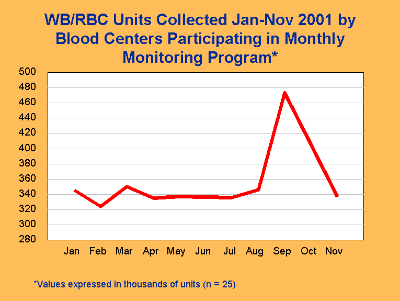|
U.S. Blood Supply Trends post-September 11, 2001
Statement of Marian T. Sullivan, MS, MPH
Executive Director
National Blood Data Resource Center
National Press Club
January 8, 2002
The National Blood Data Resource Center (NBDRC) is an independent subsidiary of the American Association of Blood Banks, and is a not-for-profit organization. We were established in 1997 to collect, analyze, and distribute data on all aspects of blood banking and transfusion medicine. NBDRC databases are truly national, consisting of quantitative data from every U.S. blood collection center and more than 2,500 hospitals, transcending the lines between national organizations, private institutions, and community-owned facilities.
Two years ago, the NBDRC began to monitor the nationís supply of blood in a statistically and geographically representative sample of blood centers on a monthly basis, for the Department of Health and Human Services. This sample accounts for 33% of U.S. blood center collections of whole blood and red cells (WB/RBCs), and has proven to be an invaluable asset. This is particularly true as we assess the effects of the tragic events of September 11th on the blood supply. I would like to take this opportunity to expand on what you have just heard regarding the recent supply in New York City, to present a broader national picture.

During the first eight months of 2001, total monthly collections of WB/RBCs averaged 342,000 units in this sample. In September, total collections increased by 38.4% to 473,000. October collections totaled 406,000, a decline of 14.2% versus September, and in November the total fell to 337,000, which was not significantly different from total collections for August (356,000).
The additional donations (those units in excess of what was expected based on the average of monthly collections) totaled 191,000 for the sample. We estimate that nationally 572,000 additional units were donated.
In early September, we predicted that a total of 14.5 million units would be collected in the U.S. in 2001. This figure was based on the results of the QuiKount Survey of all U.S. blood centers, conducted by the NBDRC in August. Our current estimate, modified according to the actual data for September through November, is that collections in 2001 surpassed 15.0 million units.
This volume exceeded the year 2000 collection total by one million units, or 7.1%. In addition, this volume would appear to meet our projection for the overall red cell transfusion demand for 2001, which was 13.5 million units. It is important to note, however, that the collection of approximately 26% of the total units donated in 2001 was concentrated in a ten-week period.
Unfortunately, there are always some units of red cells that are not utilized within the 42-day period prior to their expiration. On the average, 7,000 units were outdated monthly by the blood centers in the sample prior to September. Unused units donated on and after September 11th began to expire, or outdate, during the fourth week of October. Not unexpectedly, we began to observe a measurable increase in outdates in October. Total units reported outdated in October and November were 83,500. However, this figure may not reflect outdating of blood components on hospital blood bank shelves. The remaining donated units that passed all laboratory tests were either transfused, may have been frozen for later use, or would have reached their expiration date in December or early January. The data for December will not be available until mid-January.
The final variable from the monthly monitoring program that I would like to mention is that of inventory levels, which are actually assessed twice monthly. Total red cell inventory for the sample increased from 29,000 units in the first week of September to 113,000 units in the third week of October, when the inventory curve began to level off. By the first week of December, the inventory total was 82,000, still nearly three times the pre-September 11th level. So, although collections appear to have dropped off rather rapidly, the effect of the increased donations on inventory levels is more prolonged, due in part to the lag in expiration of the units.
The NBDRC will have additional information related to the utilization of the units collected in 2001 later this year, after the completion of the biennial Nationwide Blood Collection and Utilization Survey.
|